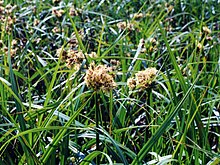Scirpus
| Scirpus | |
|---|---|

| |
| Scirpus atrovirens | |
| Scientific classification | |
| Kingdom: | Plantae |
| Clade: | Tracheophytes |
| Clade: | Angiosperms |
| Clade: | Monocots |
| Clade: | Commelinids |
| Order: | Poales |
| Family: | Cyperaceae |
| Genus: | Scirpus L. |
| Species | |
|
About 120; see text | |
| Synonyms[1] | |
| |
Scirpusis a genus of grass-like species in the sedge familyCyperaceaemany with the common namesclub-rush,wood club-rushorbulrush.They mostly inhabit wetlands and damp locations.
Description[edit]
Scirpusare rhizomatous perennial herbs, with 3-angled stems and flat grass-like leaves. The flowers are in clusters of small spikelets, often brown or greenish brown.[2]: 992 Some species (e.g.S. lacustris) can reach a height of 3 metres (10 feet), whileS. sylvaticusis about 1.2 m (4 ft) and others, such asS. supinus,are much smaller, only reaching 20–30 centimetres (8–12 in) tall.
Taxonomy[edit]
The taxonomy of the genus is complex, and under review bybotanists.Recent studies bytaxonomistsof the Cyperaceae have resulted in the creation of several new genera, including the generaSchoenoplectusandBolboschoenus;others (includingBlysmus,Isolepis,Nomochloa,andScirpoides) have also been used. At one point this genus held almost 300 species, but many of the species once assigned to it have now been reassigned, and it now holds an estimated 120 species.
Selected species[edit]
- (This list is incomplete, and may include some species now assigned to other genera.)
- Scirpus ancistrochaetusnortheastern bulrush
- Scirpus atrocinctusblack-girdle bulrush
- Scirpus atrovirenswoolgrass bulrush
- Scirpus bicolor
- Scirpus campestrissalt marsh bulrush
- Scirpus cespitosusdeergrass, synonymous withTrichophorum cespitosum
- Scirpus congdoniiCongdon's bulrush
- Scirpus cyperinus- woolgrass/cottongrass bulrush
- Scirpus diffusus
- Scirpus divaricatusspreading bulrush
- Scirpus expansusWoodland beakrush
- Scirpus flaccidifoliusreclining bulrush
- Scirpus fluitansfloating club-rush
- Scirpus fluviatilis- river bulrush
- Scirpus georgianusGeorgia bulrush
- Scirpus grossusGreater club-rush, Giant bulrush
- Scirpus hattorianus- mosquito bulrush
- Scirpus lineatusdrooping bulrush
- Scirpus longiiLong's bulrush
- Scirpus mariqueter
- Scirpus microcarpussmall-fruit bulrush
- Scirpus mucronatus
- Scirpus nevadensisNevada bulrush
- Scirpus olneyiOlney bulrush, synonymous withSchoenoplectus americanus
- Scirpus pacificusPacific Coast bulrush
- Scirpus palliduspale bulrush
- Scirpus paludosussalt marsh bulrush
- Scirpus pedicellatusstalked bulrush
- Scirpus penduluspendulous bulrush
- Scirpus polyphyllusleafy bulrush
- Scirpus pumilusdwarf deergrass
- Scirpus pungenssharp club-rush
- Scirpus radicans
- Scirpus robustussalt marsh bulrush
- Scirpus supinusdwarf club-rush
- Scirpus sylvaticuswood club-rush
- Scirpus triquetertriangular club-rush
- Selected species in a broader view of the genus
- Bolboschoenus maritimussea club-rush
- Isolepis cernuaslender club-rush
- Isolepis setaceabristle club-rush
- Schoenoplectus acutustule
- Schoenoplectus hudsonianusalpine deergrass
- Schoenoplectus lacustriscommon club-rush
- Schoenoplectus tabernaemontani
- Scirpoides holoschoenusround-headed club-rush
Fossil record[edit]
Several hundredfossilfruits ofScirpus ragoziniihave been described frommiddle Miocenestrataof the Fasterholt area nearSilkeborgin CentralJutland,Denmark.[3]Thirty-fivefossilfruits of the extantScirpus sylvaticushave been extracted fromboreholesamples of theMiddle Miocenefresh water deposits inNowy SaczBasin,West Carpathians,Poland.[4]
Distribution and habitat[edit]
The genus has a nearlycosmopolitan distribution,found on every continent exceptAfricaandAntarctica.[1]
Many species are common inwetlandsand can produce dense stands of vegetation, along rivers,[5][6]in coastal deltas[7]and in ponds and potholes.[8]Although flooding is the most important factor affecting its distribution, drought, ice scour, grazing, fire and salinity also affect its abundance.[9]It can survive unfavourable conditions like prolonged flooding, or drought, as buried seeds.[10]
Ecology[edit]
Scirpusspecies are used asfood plantsby thelarvaeof someLepidopteraspecies, includingChedra microstigma[11][12]andScirpophaga nivella.[13]They provide habitat for other wildlife.
Uses[edit]
Scirpusspecies are often planted to inhibitsoil erosion.They are also used in someherbal remedies;the plant'srhizomesare collected in the autumn and winter and dried in the sun before use.
References[edit]
- ^ab"Kew World Checklist of Selected Plant Families".Royal Botanic Garden Kew.Retrieved9 December2019.
- ^Stace, C. A.(2019).New Flora of the British Isles(Fourth ed.). Middlewood Green, Suffolk, U.K.: C & M Floristics.ISBN978-1-5272-2630-2.
- ^Angiosperm Fruits and Seeds from the Middle Miocene of Jutland (Denmark) by Else Marie Friis, The Royal Danish Academy of Sciences and Letters 24:3, 1985
- ^Łańcucka-Środoniowa M.: Macroscopic plant remains from the freshwater Miocene of the Nowy Sącz Basin (West Carpathians, Poland) [Szczątki makroskopowe roślin z miocenu słodkowodnego Kotliny Sądeckiej (Karpaty Zachodnie, Polska)]. Acta Palaeobotanica 1979 20 (1): 3-117.
- ^Auclair, A. N. D.; Bouchard, A.; Pajaczkowski, J. (1976). "Plant standing crop and productivity relations in a Scirpus–Equisetum wetland".Ecology.57(5): 941–52.doi:10.2307/1941059.JSTOR1941059.
- ^Day, R. T.; Keddy, P. A.; McNeill, J.; Carleton, T. (1988). "Fertility and disturbance gradients: a summary model for riverine marsh vegetation".Ecology.69(4): 1044–54.doi:10.2307/1941260.JSTOR1941260.
- ^Gough, L. G.; Grace, J. B.; Taylor, K. L. (1994). "The relationship between species richness and community biomass: the importance of environmental variables".Oikos.70(2): 271–9.doi:10.2307/3545638.JSTOR3545638.
- ^van der Valk, A. G. (1989).Northern Prairie Wetlands.Ames, IA: Iowa State University Press.
- ^Keddy, P.A. (2010).Wetland Ecology: Principles and Conservation(2 ed.). Cambridge, UK: Cambridge University Press.
- ^van der Valk, A. G.; Davis, C. B. (1976). "The seed banks of prairie glacial marshes".Canadian Journal of Botany.54(15): 1832–8.doi:10.1139/b76-197.
- ^Busck, August(1914)."New Microlepidoptera from Hawaii".Insecutor Inscitiae Menstruus.2(7): 106.
- ^Zimmerman, Elwood C.(1978).Insects of Hawaii(PDF).Vol.9Microlepidoptera. Honolulu: The University Press of Hawaii. pp. 1003–1015.
- ^Common, I. F. B.[in Italian](1960)."A revision of the Australian Stem Borers hitherto referred toSchoenobiusandScirpophaga(Lepidoptera: Pyralidae, Schoenobiinae) ".Australian Journal of Zoology.8(2): 307–347.doi:10.1071/ZO9600307.Retrieved9 December2019.
External links[edit]
- GenusScirpus
- GenusScirpus
- Scirpus(Cyperaceae)
- "What Is 'Schoenoplectus americanus'?" and "Should We Reject The Name 'Scirpus americanus'?"
- Edibility of Scirpus:Edible parts and identification ofScirpus
Sources[edit]
- Muntz, Philip A.A California Flora.Berkeley, CA: University of California Press, 1973, copyright 1959
- Muntz, Philip A.A California Flora: Supplement.Berkeley, CA: University of California Press, 1976 (Scirpus lacutris, validus, glaucus, p. 183))
This sectionneeds expansion.You can help byadding to it.(May 2008) |
